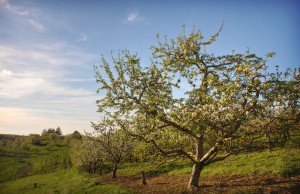Organic management in apple orchards increases beneficial fungal diversity in soils
Arbuscular mycorrhizal fungi (AMF) live in cooperative relationship with many plants. Living in the soil with plant roots, they obtain sugars from the plant and, in return, bring minerals and nutrients from the soil to the plant’s roots and protect the plant from root pathogens and predators found in the soil. Because of the great services they provide plants, they are considered an essential part of a healthy soil ecosystem and of great benefit to the health of crop plants. While variations in agricultural soils affect the abundance of AMF, very few studies have disentangled these factors with the importance of farming practices, and geographic variation in driving AMF abundances. In order to address this question, a recent study published in Molecular Ecology set out to (1) identify AMF in the roots of orchard apples and (2) determine the role of soil chemical properties, management type (organic vs. conventional) and geographic location in driving AMF diversity. Researchers sequenced the DNA of 120 apple tree roots from 24 orchards to determine the number and abundance of AMF in their roots, and then compared those results with soil, management, and geographic factors for each orchard. They found that soil characteristics and farming system were most important in shaping AMF communities. Organically managed orchards had higher AMF diversity than conventionally managed orchards and AMF diversity declined as soil fertilization increased. The authors concluded that “a combination of organic orchard management and moderate fertilization may preserve diverse AMF communities on apple trees.”



